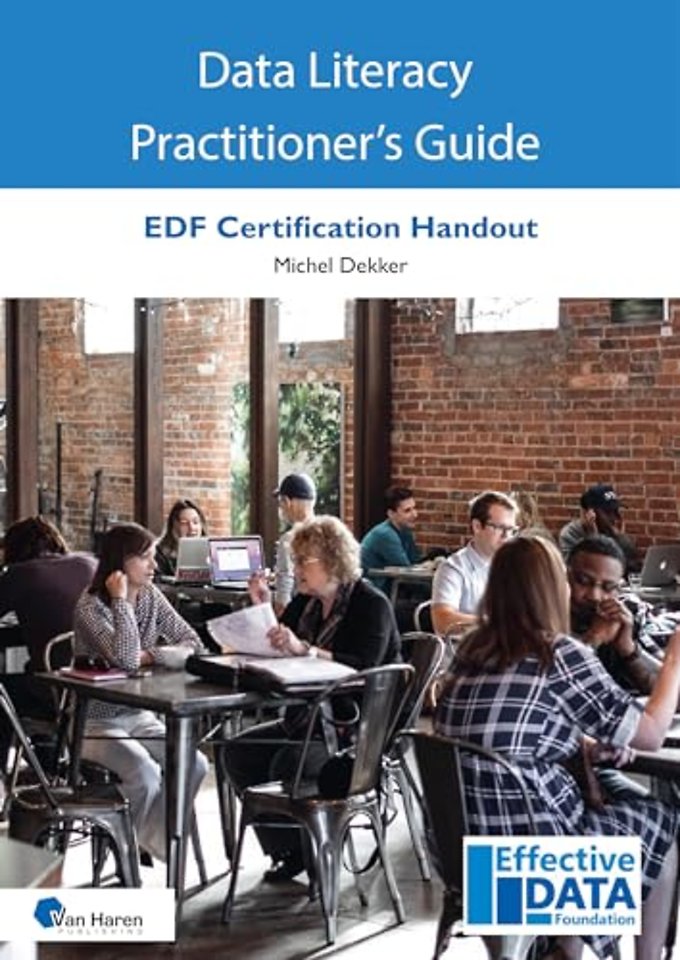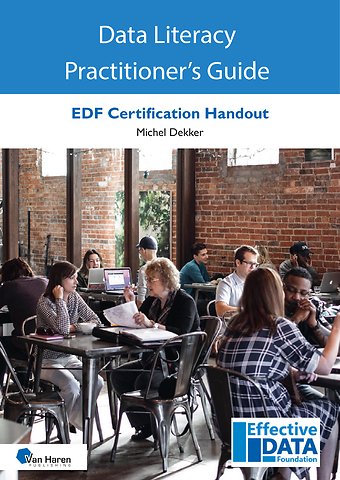Data Literacy Practitioner's Guide
EDF Data Literacy Certification workbook
Paperback Engels 2024 1e druk 9789401811316Samenvatting
As kids, we learned our native language: reading, writing, and speaking. You learn a language by starting with grammar, trying it out, making mistakes and improving it.
We are flooded with facts and figures daily, but how well do we understand the meaning behind all those numbers? How can we turn this data into value in our day-to-day work and for the organization we work for? The ability to derive meaningful information from data is called Data Literacy. Making sense of data is no longer just a skill for data scientists and technology experts but an essential skill for all of us.
Data Literacy is the ability to read, work with, analyze and argue with data.
This course is the first step to make you aware of Data Literacy (as an essential skill) and how it impacts your work. You’ll learn the fundamentals and how they relate to working in a data-informed organization. This will be enough for some people to raise the required questions when confronted with data. For others, this is the first step in becoming a fluent data speaker.
Trefwoorden
Specificaties
Lezersrecensies
Inhoudsopgave
U kunt van deze inhoudsopgave een PDF downloaden
2 INTRODUCTION 8
3 READ DATA 10
3.1 What is data? 10
3.1.1 Data scales 11
3.1.2 Why do we use data? 13
3.2 Summarize data 14
3.2.1 Central tendency 15
3.2.2 How to summarize data 17
3.3 Consume data 18
3.3.1 CHRTTS 19
3.3.2 Categorical charts 22
3.3.3 Hierarchical charts 23
3.3.4 Relational charts 24
3.3.5 Temporal charts 25
3.3.6 Tabular cCharts 26
3.3.7 Spatial charts 27
3.4 Check your data 28
4 WORK WITH DATA 32
4.1 Creating data 32
4.1.1 Automated data 32
4.1.2 Manual data 32
4.2 Data quality 33
4.2.1 Data quality dimensions 33
4.2.2 Avoid confusing data 35
4.3 Acquiring & cleaning data 36
4.3.1 Tidy data 37
4.3.2 Combine data 38
4.4 Managing data 39
4.4.1 KPI mantras 40
5 ANALYZE DATA 43
5.1 Expectations 43
5.2 Thinking shortcuts 43
5.2.1 Confirmation bias 45
5.2.2 Survivorship bias 45
5.2.3 Curse of knowledge 45
5.2.4 Correlation vs causation 46
5.3 Types of analysis 47
5.3.1 Descriptive analysis 47
5.3.2 Diagnostic analysis 48
5.3.3 Inferential analysis 48
5.3.4 Predictive analysis 49
5.3.5 Prescriptive analysis 51
5.4 Analytical skills 51
5.4.1 Variations within categories 52
5.4.2 Relations among categories 53
5.4.3 Variations within measures 53
5.4.4 Relations among measures 54
5.4.5 Look for patterns 55
6 ARGUE WITH DATA 58
6.1 Explore to explain 58
6.1.1 The data cut 59
6.1.2 The data cameo 59
6.1.3 The data decoration 60
6.2 Effective data visualization 61
6.3 Storytelling with data 62
6.3.1 The Storytelling Arc 62
6.3.2 Visual storytelling principles 64
7 FURTHER READING 72
Vergelijkbare boeken
Anderen die dit boek kochten, kochten ook
Rubrieken
- advisering
- algemeen management
- coaching en trainen
- communicatie en media
- economie
- financieel management
- inkoop en logistiek
- internet en social media
- it-management / ict
- juridisch
- leiderschap
- marketing
- mens en maatschappij
- non-profit
- ondernemen
- organisatiekunde
- personal finance
- personeelsmanagement
- persoonlijke effectiviteit
- projectmanagement
- psychologie
- reclame en verkoop
- strategisch management
- verandermanagement
- werk en loopbaan













